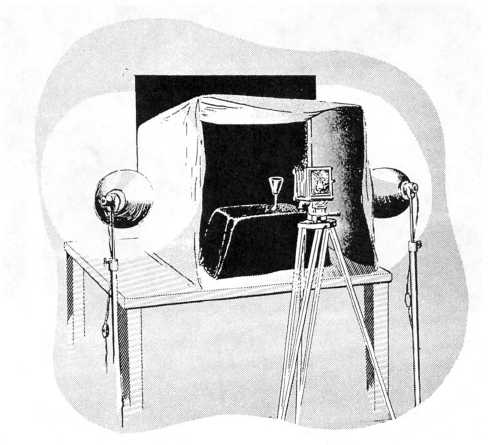Figure 6-12.–Tent lighting setup.
TENTING
Photographing small products can be quite difficult
if they include bright reflective surfaces. You can easily
see other nearby objects reflected in them and
sometimes even the whole studio. Also, light from the
lighting units may reflect off the surface very strongly
at a particular point. This can create an unwanted bright
highlight. There are two ways to get around these
problems. You could use many lights and add reflectors
to make sure the lighting is even. This may solve the
problem of light from the lighting units reflecting off the
subject surface, but unfortunately there are two great
disadvantages: it requires more lights than most photo
labs have, and you still have reflections. The other way
to solve the problem is to use the tenting technique.
The tent consists of a frame covered by a translucent
white material that casts a diffused illumination on the
subject (fig. 6-12). The lights are placed outside the tent
and directed onto the translucent material. The color of
the background, which is placed inside the tent with the
subject, depends on the subject and the effect desired.
Strips of black or colored paper taped to the inside of
the tent add the necessary dark accents or “bring to life”
a colorless object.
DULLING REFLECTIONS
Another way to control reflections is to use a matte
spray or dulling compound. Matte spray comes in a
pressurized can and is useful for the high gloss of
highlights on shiny, metal objects with curved surfaces.
When used, the spray should be applied to the entire
surface of the object. However, do not indiscriminately
spray all types of surfaces. The spray may damage some
finishes or plastics. When used on metal objects, it can
easily be wiped off after the picture is made. Matte spray
can also be applied to the back of a glass of clear liquid
to cause the backlighting to spread more evenly over the
back surface.
Cosmetic eyeliner, applied with a soft makeup or
camel-hair brush, can also be used to help control
reflections.
6-28


